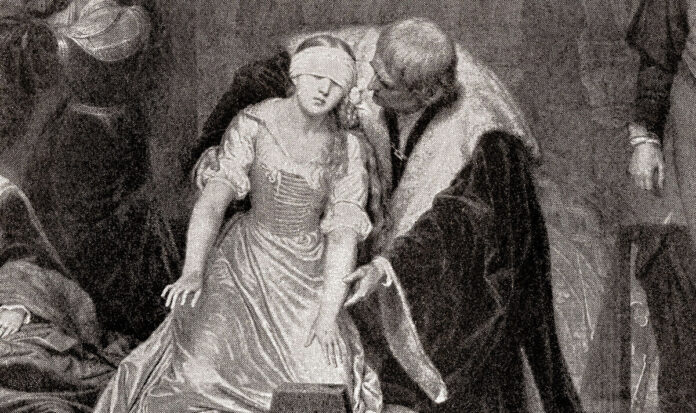Lady Jane Grey was Queen of England for just nine days (Image: GETTY) Lady Grey Jane was just 17 years old when she was beheaded with one clean stroke of an axe. Her untimely end was the result of a bitter power struggle for the English Crown , of which she was King Edward VI ‘s successor. The King named her as his replacement just before his death in July 1553 in a bid to keep his older sister, Mary, later Queen Mary I, away from the throne. Jane was successfully proclaimed Queen , but her reign was short-lived. Soon, she fell victim to red tape, complicated rules and rebellions from her opponents. Edward VI and his parents, King Henry VIII and Jane Seymour (Image: GETTY) On July 19, 1553, the attempt to install her as the Queen of England officially collapsed after a period of just nine days. Many won’t have heard of Jane, a blip in royal history. But her story is equal parts tragic and bizarre. She was born into a high-status family, with both her parents regularly at court. Her mother, Lady Frances was the daughter of Mary Tudor, Henry VIII’s youngest sister, and through her grandmother, Jane was directly linked to King Henry VIII . Reared on a stellar education, she learnt classical languages such as Greek, Latin and Hebrew as well as French and Italian. At just 10 years old she was sent to be raised in the household of Thomas Seymour, a common occurrence during the Tudor period. Aristocrats would often send their children away to be brought up by others, especially if those people were considered to be of higher status. Here, Jane would learn new etiquette and, possibly, find a future husband outside her ordinary social circle. A painting depicting the execution of Jane at Tower Hill (Image: GETTY) Thomas was the uncle of the new boy King Edward VI . He realised that Jane could help him better his standing in the royal world, and hatched a plan to marry her to the King. As third in line to the throne, Jane was a valuable asset, especially if she married Edward VI and got even closer to the Crown. Thomas knew this and kept her close. Years later, Edward, aged just 15, became severely ill, and his health never recovered. He wanted to write a succession plan to ensure a male protestant would succeed him, in the process disinheriting his half-sisters Mary and Elizabeth in favour of the male heirs of his cousin, Lady Frances Grey or of her children, Jane, Catherine and Mary. By June 1553 Edward was fatally ill, and with no clear male heir in sight, he changed his plan in favour of Jane. An artist’s impression of the arrest of Lady Jane Grey (Image: GETTY) He died on July 6, 1553, and the following Sunday, July 9, Jane was summoned and told that she was now to be crowned queen. It came as a surprise to Jane: all along people had been scheming in the background to position her as the future heir to better themselves, like John Dudley, Duke of Northumberland, who married his son, Lord Guildford Dudley, off to Jane to ensure he would become King. Her family and husband convinced her it was the right thing to do and a Coronation was arranged. But things did not go to plan. She refused to wear the crown, recalling being told that she “could take it without fear and that another also should be made, to crown my husband. Which thing I, for my part, heard truly with a troubled mind, and with ill will, even with infinite grief and displeasure of heart.” Yet, she would not allow her husband to become king without an Act of Parliament. Before she could settle the issues her reign came to an end. Her cousin, Princess Mary , the oldest daughter of Henry VIII, wrote to the Privy Council demanding to be made queen. A small army was assembled to capture Mary but her opponents failed to gauge the support she had drawn from the public. On July 19, 1553, Mary was proclaimed queen to a great rejoicing of Londoners. Jane, meanwhile, had been locked up inside the Tower of London. There was a great rush by all involved who had pushed for Jane to become queen to save themselves. What had meant to be the palace in which she was crowned had soon become the prison from which she would be sent to her death. She and her husband Guildford were tried for high treason in November 1553 and found guilty, both sentenced to death. On the morning of February 12, 1554, the authorities took Guildford from his room at the Tower to the public execution place at Tower Hill. His corpse was taken past the room Jane was staying in at the Tower, and she is reported to have exclaimed: “Oh, Guildford, Guildford!” Later that day, Jane was taken to Tower Hill and beheaded where she uttered her last words: “Lord, into thy hands I commend my spirit!” Jane and Guildford are buried in the Chapel of St Peter ad Vincula on the north side of Tower Green, with no memorial stone ever erected on their grave.
Lady Jane Grey forgotten Queen of England executed after nine days on throne
Sourceexpress.co.uk
RELATED ARTICLES


